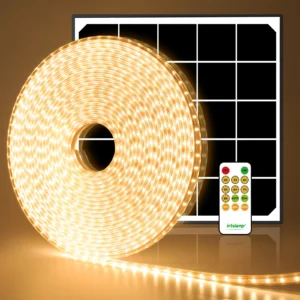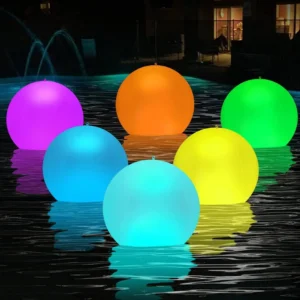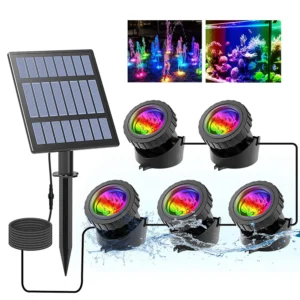Solar light sensors play a crucial role in ensuring your outdoor lights function efficiently. However, various environmental factors can cause these sensors to malfunction. In this guide, we’ll explore common issues and provide effective solutions for fixing solar light sensors.
1. Environmental Factors
Excessive Heat
Causes:
Solar light sensors are designed to detect changes in light levels, but excessive heat can hinder their performance. When exposed to prolonged sunlight, sensors can overheat, leading to damage. This often occurs in locations where solar lights are directly placed under intense sun exposure, causing the sensor to fail or malfunction.
Solutions:
- Relocate the Sensor: Move the solar light to a shaded area where it is protected from direct sunlight. This adjustment can help prevent overheating and extend the sensor’s life.
- Reconnect Wires: Ensure that all connections between the sensor and the solar panel are secure. Loose or damaged connections can exacerbate overheating issues.
- Replace the Sensor: If the sensor has become irreparably damaged due to heat, consider replacing it with a compatible new sensor. Ensure that the new sensor is rated for the environmental conditions it will face.
Excessive Cold
Causes:
Extreme cold can cause solar light sensors to become brittle and less responsive. In freezing temperatures, materials can contract and crack, impacting the sensor’s functionality. Sensors in cold climates may struggle to detect light accurately, leading to performance issues.
Solutions:
- Inspect for Damage: Regularly check the sensor for cracks or brittleness. If you find any damage, the sensor will need to be replaced.
- Clean Connections: Cold weather can lead to corrosion at connection points. Cleaning and reseating these connections, then applying a waterproof sealant, can help maintain functionality.
- Adjust Settings: If the sensor has internal settings, adjust them to recognize lower temperatures, allowing it to operate effectively even in cold conditions.
Excessive Humidity
Causes:
High humidity levels can cause moisture to accumulate in and around solar light sensors, leading to corrosion. This is particularly common in areas with frequent rain, fog, or proximity to water bodies. Corroded sensors may fail to operate correctly or stop working altogether.
Solutions:
- Keep Dry: To combat humidity, ensure solar lights are placed away from direct water exposure. This includes avoiding areas prone to standing water or frequent rain.
- Check Connections: Regularly inspect wiring and connections for signs of moisture damage or corrosion. Tightening and sealing connections can help prevent issues.
- Clean the Sensor: If moisture has already affected the sensor, clean it thoroughly. If corrosion is severe, replacing the sensor might be necessary to restore functionality.
Excessive Dust and Debris
Causes:
Accumulation of dust and debris can block the solar light sensor, preventing it from detecting light levels accurately. Environments with heavy dust, such as near construction sites or busy roads, are particularly susceptible to this issue.
Solutions:
- Regular Cleaning: Establish a routine for cleaning the sensor every few months. This helps maintain its ability to detect light effectively.
- Maintenance Steps:
- Turn Off the Solar Light: For safety, ensure the light is powered down before cleaning.
- Inspect for Dirt: Look for visible dust or debris on the sensor.
- Use a Soft Cloth or Brush: Gently remove any dirt without scratching the sensor surface.
- Apply Mild Detergent if Needed: For stubborn grime, a damp cloth with mild detergent can be used, followed by drying the sensor completely.
- Reattach and Test: Once cleaned, reattach the solar light and test to ensure it’s functioning properly.
By addressing these environmental factors proactively, you can ensure your solar light sensors remain effective and enhance the longevity of your outdoor lighting solutions.
2. Malfunctioning Components
Power Supply or Circuitry Issues
Causes:
Power supply or circuitry problems can significantly impact the functionality of solar light sensors. Faulty wiring can lead to inadequate power delivery, causing the sensor to fail or behave erratically. Additionally, damage to the solar panel itself can prevent it from converting sunlight into usable energy, further hindering the operation of the light.
Faulty Wiring: Over time, wiring can become frayed, corroded, or damaged due to exposure to weather elements or wear and tear. This can disrupt the electrical flow needed for the sensor to function.
Damaged Solar Panel: Physical damage, such as cracks or water infiltration, can prevent the solar panel from effectively capturing and converting sunlight. This limits the power available to the light sensor and the overall lighting system.
Solutions:
Inspect for Damage: Regular inspections of the entire solar lighting system are crucial. Check the wiring for visible signs of wear or damage, such as fraying, corrosion, or loose connections. Inspect the solar panel for cracks or other physical impairments that could affect its performance.
Repair Damaged Wiring: If any wiring issues are found, they should be addressed immediately. This may involve re-splicing frayed wires, replacing sections of damaged wiring, or securing loose connections to ensure a reliable power supply to the sensor.
Replace the Solar Panel: If the solar panel is severely damaged and cannot be repaired, replacing it is essential. Ensure that the new panel is compatible with the existing system to guarantee optimal performance.
Test Circuitry: After any repairs, thoroughly test the circuitry to ensure everything is functioning as intended. This includes checking connections between the solar panel, battery, light, and sensor. A multimeter can be used to measure voltage and ensure power is flowing correctly throughout the system.
By proactively addressing power supply and circuitry issues, you can maintain the reliability of your solar lights and ensure that the sensors work effectively. Regular maintenance and prompt repairs will help to prevent future malfunctions and extend the lifespan of your outdoor lighting systems.
3. Drained Battery
Causes:
A drained battery is one of the most common reasons for solar light sensor malfunctions. Over time, batteries can lose their ability to hold a charge, which directly affects the performance of the solar light. Several factors can contribute to battery drain:
Low Battery Life: Batteries have a finite lifespan, typically ranging from 1 to 3 years, depending on the type and usage conditions. As they age, their capacity diminishes, leading to insufficient power to operate the sensor and light effectively.
Inadequate Sunlight Exposure: If solar lights are placed in areas with limited sunlight, the batteries may not receive enough energy to fully charge. This can be exacerbated by seasons with shorter daylight hours or prolonged cloudy weather.
Frequent Use: Lights that are triggered frequently or left on for extended periods may deplete their batteries faster, especially if the battery is already aging.
Solutions:
Replace the Battery: If the battery is drained or has reached the end of its lifespan, it should be replaced with a new one. When selecting a replacement, ensure it matches the specifications of the original battery (e.g., voltage and type). This will help restore the functionality of the solar light and its sensor.
Check Wiring and Connectors: After replacing the battery, inspect the wiring and connectors for any signs of damage or corrosion. Securely attach all connections to ensure the new battery receives power effectively. Loose or corroded connections can hinder performance, even with a new battery.
Clean the Sensor: A dirty or obstructed sensor can also affect performance by causing false readings. Use a soft cloth to gently wipe the sensor, removing any dust, dirt, or debris that may hinder its ability to detect light accurately. This simple maintenance step can significantly improve the sensor’s responsiveness.
Monitor Battery Health: Regularly check the condition of the battery, especially during seasonal changes. Keeping track of battery performance can help you anticipate when it might need replacement and prevent unexpected failures.
By addressing battery-related issues promptly, you can ensure your solar lights function optimally. Regular maintenance, including battery checks and sensor cleaning, will extend the life of your solar lighting systems and enhance their overall efficiency.
Conclusion
Maintaining your solar light sensor is essential for optimal performance. By following these troubleshooting steps, you can effectively address common issues and extend the lifespan of your solar lights. Regular maintenance will help prevent future malfunctions and ensure your outdoor spaces remain well-lit.


















